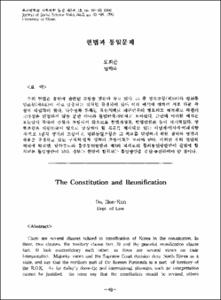惡臭汚染 事例硏究를 통한 惡臭汚染 防止 및 管理對策
- Alternative Title
- Odor Pollution Prevention and Management Strategies via Odor Pollution Case Studies
- Abstract
- 본 연구의 목적은 석유화학산업 지역에서 악취의 외부이동을 감축하기위한 방법론을 개발하고 악취제어사례를 예견하거나 석유화학산업 지역에서 악취영향을 점검하기 위한 악취오염 방지 및 관리전략 수립시 예비지침을 제공하기 위한 것이다.
실제 기상자료와 악취발생원강도를 ISCST 분산모델에 입력시켜 착지점에서의 악취농도수준(o. u.)을 계산할 수 있었다. 본 모델링연구는 1 악취단위전략과 악취완충거리의 개념을 도입하여 석유화학산?? 지역에서의 악취제거 및 예측을 수행하는 독특한 방법이라 할 수 있다.
결론적으로, 1 악취단위전략과 악취완충거리 개념을 도입하여 풍하거리에 따른 지표면 악취 농도수준을 예측하는 악취 분산모델링 방법론은 공단에서 배출된 악취오염물질의 제어 및 예측을 위해 악취저감 대책을 위한 전략수립시 예비지침서로 사용될 수 있을 것이다.
The objective of this study is to create a methodolgy for reductions in off-site odor migrations at petrochemical industrial sites, and to provide the preliminary guideline in predicting the odor control episodes or in establishing the odor pollution prevention and management strategies for review of odor impact at petrochemical industrial sites.
By incorporating the actual meteorological data and odor source strength into the ISCST dispersion model, odor concentration levels(o. u.) at receptors could be calculated. This odor modeling study is a unique approach to odor control and predictions at petrochemical industrial sites using 1 odor unit strategy and odor buffer distance concepts.
Consequently, this odor dispersion modeling methodology predicting the ground-level downwind plume centerline odor concentration levels by using 1 odor unit strategy and odor buffer distance concepts can be used as a preliminary guideline in establishing odor reduction management strategy for odor control and prediction at industrial complex sites.
The objective of this study is to create a methodolgy for reductions in off-site odor migrations at petrochemical industrial sites, and to provide the preliminary guideline in predicting the odor control episodes or in establishing the odor pollution prevention and management strategies for review of odor impact at petrochemical industrial sites.
By incorporating the actual meteorological data and odor source strength into the ISCST dispersion model, odor concentration levels(o. u.) at receptors could be calculated. This odor modeling study is a unique approach to odor control and predictions at petrochemical industrial sites using 1 odor unit strategy and odor buffer distance concepts.
Consequently, this odor dispersion modeling methodology predicting the ground-level downwind plume centerline odor concentration levels by using 1 odor unit strategy and odor buffer distance concepts can be used as a preliminary guideline in establishing odor reduction management strategy for odor control and prediction at industrial complex sites.
- Issued Date
- 1994
- Type
- Research Laboratory
- Alternative Author(s)
- Song, Duk-Man; Choi, Jong-Man
- Publisher
- 공학연구논문집
- Language
- kor
- Rights
- 울산대학교 저작물은 저작권에 의해 보호받습니다.
- Citation Volume
- 25
- Citation Number
- 2
- Citation Start Page
- 315
- Citation End Page
- 330
- Appears in Collections:
- Research Laboratory > Engineering Research
- 파일 목록
-
-
Download
 000002025072.pdf
기타 데이터 / 1.04 MB / Adobe PDF
000002025072.pdf
기타 데이터 / 1.04 MB / Adobe PDF
-
Items in Repository are protected by copyright, with all rights reserved, unless otherwise indicated.